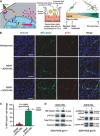Artificial cells drive neural differentiation
- PMID: 32948587
- PMCID: PMC7500934
- DOI: 10.1126/sciadv.abb4920
Artificial cells drive neural differentiation
Abstract
We report the construction of artificial cells that chemically communicate with mammalian cells under physiological conditions. The artificial cells respond to the presence of a small molecule in the environment by synthesizing and releasing a potent protein signal, brain-derived neurotrophic factor. Genetically controlled artificial cells communicate with engineered human embryonic kidney cells and murine neural stem cells. The data suggest that artificial cells are a versatile chassis for the in situ synthesis and on-demand release of chemical signals that elicit desired phenotypic changes of eukaryotic cells, including neuronal differentiation. In the future, artificial cells could be engineered to go beyond the capabilities of typical smart drug delivery vehicles by synthesizing and delivering specific therapeutic molecules tailored to distinct physiological conditions.
Copyright © 2020 The Authors, some rights reserved; exclusive licensee American Association for the Advancement of Science. No claim to original U.S. Government Works. Distributed under a Creative Commons Attribution License 4.0 (CC BY).
Figures




Similar articles
-
Genetically engineered mesenchymal stem cells as a nitric oxide reservoir for acute kidney injury therapy.Elife. 2023 Sep 11;12:e84820. doi: 10.7554/eLife.84820. Elife. 2023. PMID: 37695201 Free PMC article.
-
Pharmacologically active microcarriers delivering BDNF within a hydrogel: Novel strategy for human bone marrow-derived stem cells neural/neuronal differentiation guidance and therapeutic secretome enhancement.Acta Biomater. 2017 Feb;49:167-180. doi: 10.1016/j.actbio.2016.11.030. Epub 2016 Nov 16. Acta Biomater. 2017. PMID: 27865962
-
Recapitulation of in vivo-like paracrine signals of human mesenchymal stem cells for functional neuronal differentiation of human neural stem cells in a 3D microfluidic system.Biomaterials. 2015 Sep;63:177-88. doi: 10.1016/j.biomaterials.2015.06.011. Epub 2015 Jun 14. Biomaterials. 2015. PMID: 26113074
-
Cross-talk signals in the CNS: role of neurotrophic and hormonal factors, adhesion molecules and intercellular signaling agents in luteinizing hormone-releasing hormone (LHRH)-astroglial interactive network.Front Biosci. 1997 Mar 1;2:d88-125. doi: 10.2741/a177. Front Biosci. 1997. PMID: 9159216 Review.
-
Adult neural stem/progenitor cells in neurodegenerative repair.Sheng Li Xue Bao. 2003 Jun 25;55(3):233-44. Sheng Li Xue Bao. 2003. PMID: 12817287 Review.
Cited by
-
Spatiotemporal Communication in Artificial Cell Consortia for Dynamic Control of DNA Nanostructures.ACS Cent Sci. 2024 Jul 22;10(8):1619-1628. doi: 10.1021/acscentsci.4c00702. eCollection 2024 Aug 28. ACS Cent Sci. 2024. PMID: 39220708 Free PMC article.
-
Network topology-directed design of molecular CPU for cell-like dynamic information processing.Sci Adv. 2022 Aug 12;8(32):eabq0917. doi: 10.1126/sciadv.abq0917. Epub 2022 Aug 10. Sci Adv. 2022. PMID: 35947658 Free PMC article.
-
A Lipid-Based Droplet Processor for Parallel Chemical Signals.ACS Nano. 2021 Dec 28;15(12):20214-20224. doi: 10.1021/acsnano.1c08217. Epub 2021 Nov 17. ACS Nano. 2021. PMID: 34788543 Free PMC article.
-
Nanoprogrammed Cross-Kingdom Communication Between Living Microorganisms.Nano Lett. 2022 Mar 9;22(5):1836-1844. doi: 10.1021/acs.nanolett.1c02435. Epub 2022 Feb 16. Nano Lett. 2022. PMID: 35171622 Free PMC article.
-
Chemical communication at the synthetic cell/living cell interface.Commun Chem. 2021 Nov 25;4(1):161. doi: 10.1038/s42004-021-00597-w. Commun Chem. 2021. PMID: 36697795 Free PMC article. Review.
References
-
- Schwille P., Spatz J., Landfester K., Bodenschatz E., Herminghaus S., Sourjik V., Erb T. J., Bastiaens P., Lipowsky R., Hyman A., Dabrock P., Baret J.-C., Vidakovic-Koch T., Bieling P., Dimova R., Mutschler H., Robinson T., Tang T.-Y. D., Wegner S., Sundmacher K., MaxSynBio: Avenues towards creating cells from the bottom up. Angew. Chem. Int. Ed. Engl. 57, 13382–13392 (2018). - PubMed
-
- Deng N.-N., Yelleswarapu M., Zheng L., Huck W. T. S., Microfluidic assembly of monodisperse vesosomes as artificial cell models. J. Am. Chem. Soc. 139, 587–590 (2017). - PubMed
-
- Elani Y., Law R. V., Ces O., Vesicle-based artificial cells as chemical microreactors with spatially segregated reaction pathways. Nat. Commun. 5, 5305 (2014). - PubMed
Publication types
LinkOut - more resources
Full Text Sources
Research Materials

